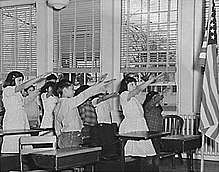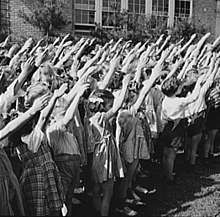Bellamy salute
The Bellamy salute is a palm-out salute described by Francis Bellamy, the author of the American Pledge of Allegiance, as the gesture which was to accompany the pledge. During the period when it was used with the Pledge of Allegiance, it was sometimes known as the "flag salute". Both the Pledge and its salute originated in 1892. Later, during the 1920s and 1930s, Italian fascists and Nazi Germans adopted a salute which was very similar, and which was derived from the Roman salute, a gesture that was popularly (albeit erroneously) believed to have been used in ancient Rome.[1] This resulted in controversy over the use of the Bellamy salute in the United States. It was officially replaced by the hand-over-heart salute when Congress amended the Flag Code on December 22, 1942.

History



The inventor of the Bellamy salute was James B. Upham, junior partner and editor of The Youth's Companion.[2] Bellamy recalled that Upham, upon reading the pledge, came into the posture of the salute, snapped his heels together, and said "Now up there is the flag; I come to salute; as I say 'I pledge allegiance to my flag,' I stretch out my right hand and keep it raised while I say the stirring words that follow."[2]
The Bellamy salute was first demonstrated on October 12, 1892, according to Bellamy's published instructions for the "National School Celebration of Columbus Day":
At a signal from the Principal the pupils, in ordered ranks, hands to the side, face the Flag. Another signal is given; every pupil gives the flag the military salute – right hand lifted, palm downward, to align with the forehead and close to it. Standing thus, all repeat together, slowly, “I pledge allegiance to my Flag and the Republic for which it stands; one Nation indivisible, with Liberty and Justice for all.” At the words, “to my Flag,” the right hand is extended gracefully, palm upward, toward the Flag, and remains in this gesture till the end of the affirmation; whereupon all hands immediately drop to the side.
— From The Youth’s Companion, 65 (1892): 446.
In the 1920s, Italian fascists adopted what has been called the Roman salute to symbolize their claim to have revitalized Italy on the model of ancient Rome. A similar ritual was adopted by the German Nazis, creating the Nazi salute. Controversy grew in the United States on the use of the Bellamy salute given its similarity to the fascist salutes. School boards around the country revised the salute to avoid this similarity. There was a counter-backlash from the United States Flag Association and the Daughters of the American Revolution, who felt it inappropriate for Americans to have to change the traditional salute because foreigners had later adopted a similar gesture.[3]
From 1939 until the attack on Pearl Harbor, detractors of Americans who argued against intervention in World War II produced propaganda using the salute to lessen those Americans' reputations. Among the anti-interventionist Americans was aviation pioneer Charles Lindbergh. Supporters of Lindbergh's views would claim that Lindbergh did not support Adolf Hitler and that pictures of him appearing to do the Nazi salute were actually pictures of him using the Bellamy salute. In his Pulitzer Prize winning biography Lindbergh (1998), author A. Scott Berg explains that interventionist propagandists would photograph Lindbergh and other isolationists using this salute from an angle that left out the American flag, so it would be indistinguishable from the Hitler salute to observers.[4][5]
.jpg)
On June 22, 1942, at the urging of the American Legion and the Veterans of Foreign Wars, Congress passed Public Law 77-623, which codified the etiquette used to display and pledge allegiance to the flag. This included use of a palm-out salute, specifically that the pledge "be rendered by standing with the right hand over the heart; extending the right hand, palm upward, toward the flag at the words 'to the flag' and holding this position until the end, when the hand drops to the side." Congress did not discuss or take into account the controversy over use of the salute. Congress later amended the code on December 22, 1942 when it passed Public Law 77-829, stating among other changes, that the pledge "be rendered by standing with the right hand over the heart."[6]
Other uses
A hand gesture similar to Bellamy Salute is commonly used during National Pledge (India) in schools all over the country.
See also
References
- Winkler, Martin M. (2009). The Roman Salute: Cinema, History, Ideology. Ohio State University Press. p. 2. ISBN 0814208649.
- Miller, Margarette S. (1976). Twenty Three Words: A Biography of Francis Bellamy: Author of the Pledge of Allegiance. Natl Bellamy Award. ISBN 978-0-686-15626-0.
- Ellis, Richard (2005). To the Flag: The Unlikely History of the Pledge of Allegiance (illustrated ed.). University Press of Kansas. pp. 113–116.
- Birkhead, L.M. "Is Lindbergh a Nazi?" charleslindbergh.com. Retrieved: January 19, 2011.
- "When Is a Nazi Salute Not a Nazi Salute?". The New York Review of Books.
- Ellis, Richard (2005). To the Flag: The Unlikely History of the Pledge of Allegiance (illustrated ed.). University Press of Kansas. pp. 116–118.
Further reading
- Berg, A. Scott (September 1, 1999). Lindbergh. New York City: Berkley Trade. ISBN 978-0425170410. Retrieved January 13, 2015.
External links
| Wikimedia Commons has media related to Bellamy salutes. |